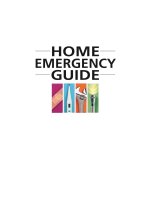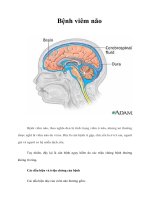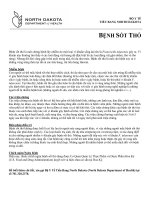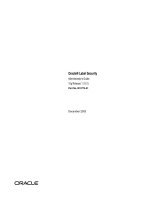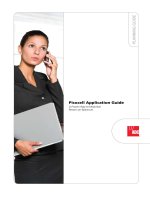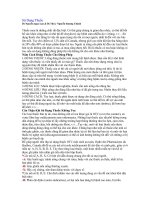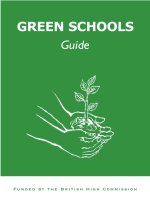Tài liệu HOME EMERGENCY GUIDE docx
Bạn đang xem bản rút gọn của tài liệu. Xem và tải ngay bản đầy đủ của tài liệu tại đây (7.3 MB, 260 trang )
HOME
EMERGENCY
GUIDE
DK Publishing
HOME
EMERGENCY
GUIDE
C
ONTRIBUTORS
Dr. Vivien Armstrong
•
Dr. Sue Davidson
•
Professor Ian Davis
David Holloway
•
John McGowan
•
Tony Wilkins
David R.Goldmannn
MD FACP
•
Allen R.Walker
MD
•
John Cunningham
Produced for Dorling Kindersley by
C
OOLING
B
ROWN
9–11 High Street, Hampton,
Middlesex TW12 2SA
Project Editor
•
Alison Bolus
Senior Designer
•
Tish Mills
Creative Director
•
Arthur Brown
Managing Editor
•
Amanda Lebentz
D
ORLING
K
INDERSLEY
Senior Managing Editor
•
Jemima Dunne
Managing Art Editor
•
Louise Dick
Senior Art Editor
•
Marianne Markham
DTP Designer
•
Julian Dams
DK P
UBLISHING
Senior Editor
•
Jill Hamilton
Senior Art Editor
•
Susan St. Louis
Editorial Assistant
•
Kate Hamill
Every effort has been made to ensure that the information contained in this book is complete and
accurate. However, the publisher is not engaged in rendering professional advice or services to the
individual reader. The ideas, procedures and suggestions contained in this book are general and not
intended as a substitute for consulting a relevant specialist in individual cases. The publisher would in
any event always advise the reader to consult his or her doctor or other health professional for specific
information on personal health matters. The publisher cannot accept any legal responsibility for any
loss or damage allegedly arising from any information or suggestion contained in this book.
First published in the United States in 2003 by
DK Publishing, Inc.
375 Hudson Street, New York, New York 10014
00 01 02 03 04 05 10 9 8 7 6 5 4 3 2 1
Copyright © 2002 Dorling Kindersley
All rights reserved under International and Pan-American Copyright Conventions. No part of this
publication may be reproduced, stored in a retrieval system, or transmitted in any form or by any
means, electronic, mechanical, photocopying, recording, or otherwise, without the prior written
permission of the copyright owner.
A catalog record for this book is available from the Library of Congress.
ISBN 0-7894-9346-2
Color reproduction by GRB Editrice, Verona, Italy
Printed and bound in Singapore by Star Standard Industries (Pte.) Ltd.
See our complete product line at
www.dk.com
LONDON, NEW YORK,
MUNICH, MELBOURNE, AND DELHI
C
ONTENTS
Action in an emergency .................10
Resuscitation techniques ................12
Choking
(adults and children)
...........................22
Choking
(babies under 1)
.................................24
Heart attack.....................................25
Asthma attack .................................26
Shock................................................27
Anaphylactic shock .........................28
Head injury ......................................29
Stroke...............................................30
Severe bleeding...............................31
Penetrating chest
wounds ............................................32
Cuts and scrapes..............................33
Splinters ...........................................34
Eye wound.......................................35
Foreign object in the eye ...............36
Chemicals in the eye .......................37
Bleeding from the mouth ..............38
Nosebleed ........................................39
Emergency childbirth......................40
Major seizures .................................42
Febrile seizures................................43
Broken arm......................................44
Broken leg .......................................45
Spinal injuries ..................................46
Sprains and strains ..........................47
Severe burns ....................................48
Minor burns and scalds...................49
Sunburn ...........................................50
Heat exhaustion ..............................51
Heatstroke .......................................52
Fainting............................................53
Hypothermia ...................................54
Frostbite...........................................55
Swallowed poisons ..........................56
Snake and spider bites....................57
Animal and tick bites.....................
58
Insect and
scorpion stings ...................59
First-aid equipment ........60
1
FIRST AID
How to use this section .................66
Assessing symptoms
(adults)
...........68
Assessing symptoms
(children)
..........................................70
Not feeling well .............................72
Fever
(adults)
...................................74
Fever
(children)
................................76
Excessive sweating .........................78
Lumps and swellings ......................80
Feeling faint /passing out ..............82
Headache ........................................84
Vertigo ............................................86
Numbness and /or tingling ............88
Facial pain.......................................90
Difficulty speaking .........................91
Forgetfulness or confusion............92
General skin problems....................94
Rash with fever ..............................96
Eye pain or irritation ......................98
Disturbed/impaired vision ...........100
Earache .........................................102
Sore throat ...................................103
Hoarseness or
loss of voice ..................................104
Coughing
(adults)
..........................106
Coughing
(children)
.......................108
Shortness of breath
(adults)
...........................................110
Breathing problems
(children)
........................................112
Wheezing......................................114
Difficulty swallowing....................115
Vomiting
(adults)
...........................116
Vomiting
(children)
........................118
Abdominal pain
(adults)
...........................................120
Abdominal pain
(women)
.........................................122
Abdominal pain
(children)
........................................124
Abdominal swelling .....................126
Anal and rectal problems ............127
Diarrhea
(adults)
............................128
Diarrhea
(children)
.........................130
Constipation .................................132
Chest pain .....................................134
Palpitations...................................136
Poor bladder control ....................137
Painful urination ..........................138
Back pain ......................................140
Neck pain or stiffness....................142
Arm or hand pain ........................144
Leg pain ........................................145
Joint pain ......................................146
Swollen ankles..............................148
Erectile dysfunction .....................150
Testes and scrotum
problems .......................................151
Penis problems .............................152
Breast problems ...........................154
Painful menstrual periods ...........156
Heavy menstrual periods .............157
Abnormal vaginal
bleeding........................................158
Vaginal discharge .........................160
Genital irritation
(women)
.........................................161
Home medicine chest ....................162
Caring for a sick person...............164
2
FAMILY ILLNESS
Planning for disaster....................220
Severe storm .................................226
Flood .............................................228
Extreme cold .................................230
Wildfire .........................................232
Hurricane ......................................234
Tornado.........................................236
Earthquake ...................................238
Volcanic eruption .........................240
Tsunami.........................................242
Post-disaster survival ....................244
Useful addresses
and online listings........................250
Index .............................................253
Acknowledgments .......................256
Home safety..................................172
Yard safety ....................................178
Fires in the home .........................180
Gas leaks .......................................184
Plumbing
problems .......................................186
Central-heating
problems .......................................192
Air-conditioning
problems .......................................194
Electrical problems .......................196
Structural problems......................200
Insects and pests...........................208
Furniture and
furnishings ....................................210
Home security ...............................212
3
HOUSEHOLD EMERGENCIES
4
NATURAL DISASTERS
Knowing what to do in a medical emergency, such as when someone
suffers a heart attack, a deep chest wound, or a snake bite, could save
the victim’s life. This section tells you how to recognize important
symptoms and give appropriate first-aid treatment in a wide range
of situations, with full details on resuscitating an unconscious person.
Action in an
emergency .....................10
Resuscitation
techniques .....................12
Choking
(adults and children)
.........22
Choking
(babies under 1)
...............24
Heart attack...................25
Asthma attack ...............26
Shock..............................27
Anaphylactic shock .......28
Head injury....................29
Stroke.............................30
Severe bleeding ............31
Penetrating chest
wounds ..........................32
Cuts and scrapes............33
Splinters .........................34
Eye wound.....................35
Foreign object
in the eye.......................36
Chemicals
in the eye.......................37
Bleeding from
the mouth .....................38
Nosebleed......................39
Emergency
childbirth .......................40
Major seizures ...............42
Febrile seizures..............43
Broken arm....................44
Broken leg .....................45
Spinal injuries................46
Sprains and strains ........47
Severe burns..................48
Minor burns
and scalds ......................49
Sunburn .........................50
Heat exhaustion............51
Heatstroke .....................52
Fainting..........................53
Hypothermia .................54
Frostbite.........................55
Swallowed poisons........56
Snake and
spider bites ....................57
Animal and
tick bites ........................58
Insect and
scorpion stings...............59
First-aid equipment ......60
1
FIRST
AID
FIRST AID
Action in an emergency
10
ACTION PLAN
ACTION
ELIMINATE DANGER,
OR REMOVE THE
VICTIM FROM
DANGER, ONLY IF
YOU CAN DO SO
WITHOUT PUTTING
YOURSELF AT RISK.
DIAL 911.
ACTION
PLACE VICTIM IN THE
RECOVERY POSITION
(pp.14–15).
CHECK
FOR SIGNS OF INJURY.
DIAL 911 OR CALL
EMS.
ACTION
CHECK THE
VICTIM’S INJURIES
(p.11)
AND TREAT
AS APPROPRIATE.
CALL FOR HELP IF
NECESSARY.
Yes
No
Are you and/or
the victim in
any danger?
Yes
No
Is the victim
talking to you?
Yes
No
Is the victim
breathing?
Yes
No
Dial 911 or
call EMS.
Give rescue
breaths
(pp.16–17). Are
there any signs
of circulation?
START
ACTION
GIVE CPR
(pp.18–20).
ACTION
CONTINUE RESCUE
BREATHS
.
When faced with an emergency, try to remain calm and controlled so that you
can act effectively. Before assessing the victim’s condition and carrying out
the appropriate first aid, make sure that you are not putting yourself in danger.
You will not be able to help anyone else if you become a victim yourself.
If possible, have someone else dial 911 while you deal with the situation.
Yes
No
Is the victim
conscious?
11
ACTION IN AN EMERGENCY
CALLING AN AMBULANCE
1
Dial 911
•
Check the victim’s breathing
before calling for help.
•
If possible, send someone else to
make the call and ask him or her
to confirm that help is on the way.
•
If you are alone with a child who
is unconscious or an adult who
has drowned, choked, or been
injured, give rescue breaths
(pp.16–17) and/or CPR (pp.18–20)
for 1 minute before making the call.
•
If you are alone with an adult who
is not breathing and you suspect a
heart attack, dial 911 immediately.
•
If you have to leave a victim who
is breathing, place him in the
recovery position (pp.14–15).
ASSESSING A VICTIM’S INJURIES
•
Deal first with any life-threatening
conditions the victim may have,
such as unconsciousness (p.21),
breathing difficulties (p.12), or
heavy loss of blood (p.31).
•
Check for and treat any
other injuries.
Check the victim to
assess her injuries
2
Give information
•
Tell the ambulance dispatcher
where you are, your telephone
number, what has happened, the
age, sex, condition, and injuries of
the victim(s), and whether any
hazards are still present, such as
a fire or gasoline on the road.
3
Give first aid
•
Give the appropriate first-aid to
the victim.
•
Stay with the victim until medical
help arrives.
•
Monitor the victim’s breathing
(p.68 for an adult, p.71 for a child),
pulse (p.68 for an adult, p.70 for
a child), and consciousness (p.12)
until the ambulance arrives.
Monitor the victim’s
condition while
waiting for the
ambulance
12
FIRST AID
The techniques on the following pages, used in sequence, can help maintain a
victim’s oxygen supply until help arrives. Upon finding an unconscious person,
you need to open and, if necessary, clear the victim’s airway so that air can enter
the lungs. If the victim is not breathing, give rescue breaths to maintain the oxygen
supply, thereby sustaining the victim’s vital organs. If the victim also has no
circulation, give cardiopulmonary resuscitation (CPR) – rescue breaths with chest
compressions – to ensure that air enters the body and is circulated by the blood.
An unconscious victim who is breathing should be placed in the recovery position,
a secure position that keeps the airway open and the head, neck, and back aligned.
CHECKING FOR CONSCIOUSNESS (all ages)
Resuscitation techniques
1
Seek reaction
•
Ask a simple question, or give
a simple command, such as
“Open your eyes.”
•
Shake an adult’s shoulders gently.
!
Important
•
Never shake a baby or child. Instead,
gently tap the shoulder or flick the
sole of the foot.
2
Assess response
•
If the victim responds to
speech, assess whether he is
alert and aware of the situation
or confused and sleepy.
•
If he responds to touch, assess
whether he reacts readily to your
touch or is sluggish in response.
•
If there is no reaction at all, open
the victim’s airway (p.13).
3
Monitor victim
•
During first-aid treatment, you
will need to repeat steps 1–2
every 10 minutes to check the
victim’s level of consciousness.
•
Note any changes in the victim’s
responses to speech or gentle
shaking (adult victims only),
and whether these indicate an
improvement or a deterioration
in his condition, then pass this
information on to the paramedics
when the ambulance arrives.
•
If a conscious victim becomes
unconscious, open the airway
(p.13), check breathing (p.14),
and dial 911 or call EMS.
Shake an adult
victim gently by
the shoulders to
see if he responds
13
RESUSCITATION TECHNIQUES
OPENING THE AIRWAY (adults and children)
OPENING THE AIRWAY (babies under 1)
1
Tilt head back
•
Gently place one hand on the
victim’s forehead.
•
Tilt the head back by pressing
down on the forehead.
2
Remove any
obstruction
•
Look inside the victim’s mouth.
Carefully pick out any obvious
obstruction with your fingers.
3
Lift chin
•
Place two fingers of the other hand
under the chin and lift it gently.
•
Tilt the head to open the airway.
Check breathing (p.14).
3
Lift chin
•
Place one finger of the other hand
under the chin and lift it gently.
•
Tilt the head slightly. If you tilt it
too far, you may block the airway
again. Check breathing (p.14).
Using two
fingers, gently
lift up the chin
1
Tilt head back
•
Place one hand on the baby’s
forehead, then tilt the head
by pressing on the forehead.
2
Remove any
obstruction
•
Pick out any obvious obstruction
in the mouth with your fingertips.
Do not over-
extend the
baby’s neck
!
Important
•
If you suspect that there are head
or neck injuries, handle the head
carefully. Tilt the head back slightly.
•
Do not sweep your fingers blindly
around the mouth.
BEFORE YOU START
Make sure that you have:
•
Checked for consciousness but
had no response (p.12).
BEFORE YOU START
Make sure that you have:
•
Checked for consciousness but
had no response (p.12).
Important
•
Always be very gentle with a baby’s head
when tilting it back.
!
14
FIRST AID
2
Prepare to
turn victim
•
Bring the arm farther from you
across the victim’s chest, and
place the back of his hand under
his near cheek.
•
Pull his far leg into a bent position;
keep his foot on the floor.
•
Pull his knee toward you.
Use leg as
lever to
turn body
2
Treat victim
•
If breathing has stopped, begin
rescue breaths (pp.16–17).
•
If the victim is breathing but
unconscious, place him in the
recovery position (see below and
opposite), then check for injuries.
1
Look for
movement
•
Kneel beside the victim and put
your cheek close to his mouth.
Listen and feel for any signs of
breathing, while looking along
his chest for signs of movement.
•
Do this for up to 10 seconds.
1
Position arms
and legs
•
Kneel next to the victim.
•
If the victim is wearing eyeglasses,
remove them. Also remove any
bulky objects from his pockets.
•
Position the arm closer to
you so that it lies at a right
angle to his body, with his
elbow bent at a right angle
and the palm facing upward.
CHECKING FOR BREATHING (all ages)
RECOVERY POSITION (adults and children)
BEFORE YOU START
Make sure that you have carried out
the following steps:
•
Checked for consciousness but
had no response (p.12).
•
Opened the victim’s airway (p.13).
BEFORE YOU START
Make sure that you have carried out
the following steps:
•
Checked for consciousness but had
no response (p.12).
•
Opened the victim’s airway (p.13).
•
Checked for breathing and found
definite signs (see above).
Look down
across the chest
to see if it rises
Keep palm
facing up
15
RESUSCITATION TECHNIQUES
3
Turn victim
•
Continue to pull the upper leg
so that the victim rolls onto
his side. If necessary, support his
body with your knees so that he
does not roll too far forward.
•
Leave the victim’s hand supporting
his head, and tilt the head so that
the airway stays open.
4
Support victim
•
Adjust the victim’s hand so that it
supports his head. Bend the hip and
knee of his upper leg at right angles
so that this leg supports his body.
•
Check that an ambulance is on
the way.
•
Check and record the victim’s
breathing (p.68 for an adult,
p.71 for a child), pulse (p.68
for an adult, p.70 for a child),
and consciousness (p.12)
until help arrives.
Keep
leg bent
1
Pick up baby
•
Hold the baby securely in
your arms so that his head
is lower than his body.
•
Tilt the baby’s head back
to keep the airway open
and to allow any vomit to
drain from his mouth.
•
Ensure that you keep the baby’s
head, neck, and back aligned
and supported at all times.
2
Monitor baby
•
Monitor the baby’s breathing
(p.71), pulse (p.70), and level
of consciousness (p.12)
until help arrives.
Important
•
If you suspect a spinal injury, do not move
a baby unless the breathing is impeded or
he is in danger.
!
BEFORE YOU START
Make sure that you have carried out
the following steps:
•
Checked for consciousness but
had no response (p.12).
•
Opened the baby’s airway (p.13).
•
Checked for breathing and found
definite signs (see p.14).
Important
•
If you suspect a spinal injury, do not move
the victim unless his breathing is impeded
or he is in danger. Maintain his open airway.
!
Keep the baby’s
head tilted
downward to
let fluid drain
RECOVERY POSITION (babies under 1)
16
FIRST AID
GIVING RESCUE BREATHS (adults and children)
1
Breathe into
victim’s mouth
•
Check that the victim’s airway
is still open.
•
Pinch the victim’s nose closed with
your thumb and index finger.
•
Take a deep breath, then place
your open mouth tightly around
his so that you form a good seal.
•
Blow air into his mouth for
about 2 seconds.
2
Watch chest
•
Lift your mouth away from the
victim’s mouth, keeping your
hands in place to maintain his
head position.
•
Glance at the victim’s chest; you
should see his chest fall as the air
leaves his lungs. This is called an
effective breath. Repeat the breath.
4
Check for signs
of circulation
•
Look for any signs that indicate
circulation – breathing, coughing,
and movement of limbs – for up
to 10 seconds.
•
If there are signs of circulation,
continue rescue breathing, giving
10 breaths per minute for adults
and 20 for children. Recheck for
signs of circulation every minute.
•
If the victim starts breathing
again, place him in the recovery
position (pp.14–15).
•
If there are no signs of circulation,
begin CPR (pp.18–20).
Blow steadily
into the
victim’s
mouth
3
Repeat breathing
•
If there is no chest movement,
readjust his head and try again.
•
Repeat rescue breaths up to five
times or until you achieve two
effective breaths. Then check for
signs of circulation (see step 4).
OR
•
If his chest fails to move even after
rescue breathing, check for signs
of circulation. If you know that
the victim has choked and his
chest still does not move, do
not check for circulation but
go straight to CPR (pp.18–20).
BEFORE YOU START
Make sure that you have carried out
the following steps:
•
Checked for consciousness but
had no response (p.12).
•
Opened the victim’s airway (p.13).
•
Checked for breathing but found
no signs (p.14).
Keep checking
to see if his chest
rises and falls
17
RESUSCITATION TECHNIQUES
GIVING RESCUE BREATHS (babies under 1)
1
Breathe into
baby’s mouth
•
Make sure that the baby’s airway
is still open.
•
Take a breath. Seal your lips
around both the mouth and nose.
•
Attempt to give about one breath
per second.
2
Watch chest
•
Glance at the baby’s chest; it should
rise and fall. Repeat rescue breaths.
•
If the chest does not move, readjust
the airway and try again.
•
Try up to five times or until you
achieve two effective breaths. Check
for signs of circulation.
OR
•
If the chest still does not move,
check for signs of circulation.
•
If you know the baby has choked
and the chest still does not move,
do not check for circulation but
go straight to CPR (p.20).
3
Check circulation
•
Look for any signs that indicate
circulation – breathing, coughing,
and movement of limbs – for up
to 10 seconds.
•
If there are signs of circulation,
continue rescue breathing (at a
rate of one breath per 3 seconds).
If there are no signs of circulation,
begin CPR (p.20).
pic
Important
•
If you have a face shield (p.60), use
this when giving rescue breaths to
prevent cross-infection.
•
If the victim has swallowed a corrosive
poison, use a face shield to protect
yourself from the effects of the chemical.
•
Before giving the first breath, make
sure that the victim’s head is tilted back
and the airway is open.
!
Place the
shield on the
victim’s face,
with the filter
over her mouth
BEFORE YOU START
Make sure that you have carried out
the following steps:
•
Checked for consciousness but
had no response (p.12).
•
Opened the baby’s airway (p.13).
•
Checked for breathing but found
no signs (p.14).
!
Important
•
When giving rescue breaths to a baby,
be careful not to blow too hard.
18
FIRST AID
1
Find compression
point
•
Lay the victim on a firm surface.
•
Kneel beside the victim, level with
his chest. Slide your fingers (using
the hand farther from his head)
along the lowest rib to the point
where it meets the breastbone.
•
Position your middle and index
fingers at this point.
•
Place the heel of your other hand
on the breastbone, just above your
index finger.
This is the
area of the
chest where
you must
apply the
compressions.
2
Position hands
•
Lift away the fingers of your
first hand and lay this hand on top
of your other hand.
•
Interlock your fingers, so that
the fingers of your bottom hand
are not touching the chest.
•
Kneel upright with your shoulders
directly above the victim and your
elbows locked straight.
Place fingers
where the victim’s
lower rib and
breastbone meet
3
Compress chest
•
Press downward, depressing the
breastbone by 1
1
/
2
–2 inches (4–5 cm)
on an average adult, then release
the pressure but do not remove
your hands from the chest.
•
Compress the chest in this way
15 times at a rate of about 100
compressions per minute (roughly
three every 2 seconds), maintaining
an even rhythm.
GIVING CPR (adults and children over 7)
Raise fingers
away from
the chest
Keep your hands
in position between
compressions
BEFORE YOU START
Make sure that you have carried out
the following steps:
•
Checked for consciousness but had
no response (p.12).
•
Opened the victim’s airway (p.13).
•
Checked for breathing but found no
signs (p.14).
•
Given two effective rescue breaths
and checked for signs of circulation
but found none (p.16)
OR
•
Attempted two rescue breaths and
checked for signs of circulation but
found none (p.16).
19
RESUSCITATION TECHNIQUES
5
Repeat CPR cycles
•
Continue giving cycles of 15 chest
compressions and two rescue
breaths until help arrives.
•
If the circulation returns or the
victim starts breathing at any time,
stop CPR and place him in the
recovery position (pp.14–15).
•
Stay with the victim and monitor
his breathing (p.68), pulse (p.68),
and level of consciousness (p.12)
until help arrives.
1
Find compression
point
•
Lay the child on a firm surface.
•
Find the base of
the breastbone
(see opposite),
then position
one hand on the
lower half of the
child’s breastbone.
2
Give compressions
•
Kneel upright with your shoulders
directly above the child’s chest and
your elbow locked straight.
•
Press downward, so that you
are depressing the breastbone
by one-third of the depth of the
chest, then release the pressure
without removing your hands.
•
Compress the chest five times at a
rate of about 100 compressions per
minute, keeping an even rhythm.
•
Give one rescue breath.
3
Repeat CPR cycles
•
Continue giving cycles of five chest
compressions to one rescue breath.
•
If the child’s circulation and/
or breathing return, place
him or her in the recovery
position (pp.14–15).
•
Stay with the child
and monitor his or
her breathing (p.71),
pulse (p.70), and
level of consciousness
(p.12) until help arrives.
GIVING CPR (children 1–7)
4
Give rescue breaths
•
Give the victim two rescue
breaths (p.16).
Position one
hand ready
for compressions
BEFORE YOU START
Make sure that you have carried out
the following steps:
•
Checked for consciousness but had
no response (p.12).
•
Opened the victim’s airway (p.13).
•
Checked for breathing but found no
signs (p.14).
•
Given two effective rescue breaths
and checked for signs of circulation
but found none (p.16)
OR
•
Attempted two rescue breaths and
checked for signs of circulation but
found none (p.16).
Pinch the nose
and tilt the chin
before placing
your mouth over
the victim’s
20
FIRST AID
Place two fingers
on the breastbone
just below nipple line
Seal your
mouth over
the baby’s
nose and
mouth
GIVING CPR (babies under 1)
1
Find compression
point
•
Lay the baby on a firm surface.
•
Position the tips of two fingers of
one hand on the baby’s breastbone,
a finger’s width below the nipples.
This is the point where you must
apply the compressions.
2
Compress chest
•
Press downward, so that you
depress the breastbone by one-
third of the depth of the chest,
then release the pressure without
moving your hands.
•
Compress the chest five times at a
rate of about 100 compressions per
minute, keeping an even rhythm.
•
Give one effective rescue breath.
Look for chest
movements
Listen for
breathing
!
Important
•
When giving rescue breaths to a baby,
be careful not to blow too hard.
3
Repeat CPR cycles
•
Continue giving cycles of five
chest compressions and one
rescue breath.
•
If the baby’s circulation and/or
breathing return, stop CPR
and hold him or her in the
recovery position (p.15).
•
Stay with the baby and monitor
his or her breathing (p.71), pulse
(p.70), and level of consciousness
(p.12) until help arrives.
BEFORE YOU START
Make sure that you have carried out
the following steps:
•
Checked for consciousness but
had no response (p.12).
•
Opened the baby’s airway (p.13).
•
Checked for breathing but found no
signs (p.14).
•
Given two effective rescue breaths
and checked for signs of circulation
but found none (p.17).
OR
•
Attempted two rescue breaths and
checked for signs of circulation but
found none (p.17).
21
RESUSCITATION TECHNIQUES
•
UNCONSCIOUSNESS
An interruption in the normal activity of the brain
results in unconsciousness. This potentially life-
threatening condition requires immediate medical
help. The aims of first-aid treatment are to check the
victim’s level of consciousness, open the airway and
check breathing, then, if the victim is breathing, to
put him or her in a stable position until help arrives.
TREATING UNCONSCIOUSNESS (all ages)
Unconsciousness
SIGNS & SYMPTOMS
•
No response to loud
noise or gentle shaking
•
Closed eyes
•
No movement or sound
1
Check
consciousness
•
Check the victim for signs
of consciousness (p.12).
•
Open the victim’s airway (p.13)
and check her breathing (p.14).
•
If the victim is not breathing, begin
rescue breaths (p.16 for adults and
children, p.17 for babies).
•
If the victim is breathing, place her
in the recovery position (pp.14–15
for adults and children, p.15 for
babies) and treat any injuries
(see step 3).
3
Treat injuries
•
Examine the victim gently for any
serious injuries.
•
Control any bleeding (p.31).
Check for and support suspected
broken arms or legs (pp.44–45).
4
Monitor victim
•
Stay with the victim until medical
help arrives.
•
Monitor her breathing regularly
(p.68 for an adult, p.71 for a
child or baby) and pulse (p.68
for an adult, p.70 for a child
or baby) every 10 minutes.
•
Check for any changes in the
victim’s level of consciousness by
asking simple questions or shaking
her gently every 5–10 minutes.
2
Summon help
•
Dial 911 or call EMS.
•
Look for clues to the cause of the
condition, such as needle marks,
medical warning bracelets, or
identification cards.
•
Ask bystanders for any information
they may have that you can give
to the emergency services.
Keep
leg bent
!
Important
•
Do not move the victim unnecessarily in case
there is spinal injury.
•
If you need to leave the victim to get help,
place her in the recovery position (pp.14–15
for adults and children, p.15 for babies).
•
Do not shake a baby or child.
•
Be prepared to begin resuscitation (pp.12–20).
•
Do not give an unconscious victim anything
to eat or drink.
22
FIRST AID
An obstruction of the airway, usually caused by food
or a foreign object, can result in choking. The aim of
first-aid treatment for choking is to dislodge the object
as quickly as possible. This involves encouraging the
victim to cough, then, if necessary, using thrusts. If
the obstruction is not removed, the victim will stop
breathing and lose consciousness.
TREATING CHOKING
(adults and children over 7)
Choking
(adults and children)
SIGNS & SYMPTOMS
•
Coughing, difficulty in
breathing and talking
•
Signs of distress, including
holding the throat
•
Red face and neck, later
turning gray-blue
1
Encourage
coughing
•
Ask the victim to cough. This may
dislodge whatever is blocking the
victim’s windpipe.
•
Check a child’s mouth to see if
anything has been dislodged.
2
Give abdominal
thrusts
•
If the victim is becoming weak, or
stops breathing or coughing, carry
out abdominal thrusts. Stand
behind the victim and put both
arms around the upper part of the
abdomen. Make sure he is
bending forward.
•
Clench your fist and
place it (thumb inward)
between the navel and
the bottom of the
breastbone. Grasp
your fist with your
other hand. Pull
sharply inward
and upward up to
five times.
!
Important
•
If the victim becomes unconscious,
open the airway, check breathing, and
be prepared to begin resuscitation
(pp.12–20).
•
If the victim is pregnant or obese, or
you cannot reach around the victim’s
abdomen, give chest thrusts instead of
abdominal thrusts. Position your fist in
the middle of the victim’s chest, grab
your fist with the other hand, and pull
sharply inward up to five times.
Encourage victim
to cough
3
Check mouth
•
Check his mouth. If the obstruction
is still not cleared, repeat steps 2
and 3 up to three times, checking
his mouth after each step.
•
If the obstruction still has not
cleared, Dial 911 or call EMS.
Continue until help arrives or the
victim becomes unconscious.
23
CHOKING (ADULTS AND CHILDREN)
3
Give abdominal
thrusts
•
If the child shows signs of
becoming weak, or stops
breathing or coughing, carry
out abdominal thrusts.
•
Put your arms around the child’s
upper abdomen. Make sure
that he is bending well forward.
•
Place your fist between the navel
and the bottom of the breastbone,
and grasp it with your other hand.
Pull sharply
inward and
upward up
to five times.
Stop if the
obstruction
clears.
1
Encourage
coughing
•
If the child is still able to breathe,
encourage him to cough. This may
help dislodge the obstruction, and
should always be tried before other
method, such as abdominal
thrusts, are used.
TREATING CHOKING (children 1–7)
2
Check mouth
•
Check the child’s mouth carefully
to see if anything has been
dislodged. Encourage him to spit
it out, then make sure that the
obstruction has been cleared.
4
Check mouth
•
Check the victim’s mouth again to
see if anything has been dislodged,
and remove the object carefully.
•
If the obstruction is still not
cleared, repeat steps 3 and 4 up to
three times.
•
If the obstruction still has not
cleared, dial 911 or call EMS.
•
Continue giving abdominal thrusts
until help arrives or the child
becomes unconscious.
Encourage
child to
cough
!
Important
•
Do not sweep your finger around the
child’s mouth since you might push
an object farther down the throat.
•
If the child becomes unconscious,
open the airway, check breathing,
and be prepared to begin
resuscitation (pp.12–20).
Give five
abdominal
thrusts
24
FIRST AID
Important
•
Do not blindly sweep your finger
around the mouth.
•
If the baby becomes unconscious, open
the airway, check breathing, and prepare
to begin resuscitation (pp.12–20).
•
Do not attempt to use abdominal
thrusts on a baby.
2
Give chest thrusts
•
If the baby is still
choking, lay her face
upwards and place
two fingers on her
breastbone, just
below nipple level.
•
Push sharply
into her chest
with your fingers
up to five times.
•
Check her mouth
again and remove
anything that you
can see.
Babies under 1 can easily choke on small objects.
A choking baby may squeak, turn red then blue in
the face, or appear to cry without making a noise.
The aim of first-aid treatment is to dislodge the
object as quickly as possible, using chest thrusts.
If the obstruction is not removed, the baby will
stop breathing and lose consciousness.
TREATING CHOKING
Choking
(babies under 1)
1
Give back slaps
•
Position the baby face down
along your arm, with your
hand supporting her head.
•
Slap her back sharply
up to five times.
•
Turn her over
and look in her
mouth to see if
anything has
been dislodged.
•
If it has, pick it
out carefully.
!
SIGNS & SYMPTOMS
•
High-pitched squeak-like
sounds, or no noise at all
•
Difficulty in breathing
•
Red face and neck,
turning gray-blue
3
Repeat treatment
•
If the obstruction still has
not been dislodged, repeat the
sequence of back slaps and chest
thrusts three more times.
•
If the obstruction has not been
cleared after all efforts have
been made, call an ambulance.
•
Take the baby with you when
you go to call the ambulance.
•
Repeat the treatment sequence
while you are waiting for the
ambulance to arrive.
Give five sharp
chest thrusts
Give five
back slaps
25
CHOKING (BABIES UNDER 1)
•
HEART ATTACK
A heart attack is usually caused by a blockage of
the blood supply to the heart. The aims of first-aid
treatment for a heart attack are to make the victim
comfortable and to arrange for prompt transport to
the hospital. The chances of surviving a heart attack
have improved significantly in recent years, but it
is still vital that the victim be treated by medical
professionals as soon as possible.
TREATING A HEART ATTACK
Heart attack
SIGNS & SYMPTOMS
•
Sharp chest pain often
extending down left arm
•
Nausea and vomiting
•
Feeling faint and breathless
•
Gray skin and blueish lips
•
Pulse that quickens and
then weakens
1
Make victim
comfortable
•
Raise the victim’s shoulders so that
he is half-sitting and support him
with cushions or pillows.
•
Bend his knees and support them
with more pillows.
•
Reassure him and keep him as
calm as possible.
2
Summon help
•
Dial 911 or call EMS. Tell the
dispatcher that you are with
someone who is probably
having a heart attack.
•
Call the victim’s doctor, if you are
requested to do so.
3
Help with
medication
•
If the victim has medication for
angina, help her take it.
4
Monitor condition
•
Keep the victim calm and rested.
•
Check and record the victim’s
breathing (p.68), pulse (p.68), and
level of consciousness (p.12) until
medical help arrives.
Important
•
Do not allow the victim to eat or drink.
•
If the victim falls unconscious, open his
airway, check breathing, and be prepared
to begin resuscitation (pp.12–20).
Prop up legs
with cushions
or pillows
Support victim’s
back with cushions
or pillows
!

